Financial Intermediation Assignment 3: Lehman Collapse Reflections
VerifiedAdded on 2023/05/29
|6
|1596
|202
Homework Assignment
AI Summary
This finance assignment analyzes the concepts of moral hazard and securitization within the context of the Canadian and global financial markets, with specific reference to Hyun Son Shin's speech on the Lehman Brothers collapse. The solution explores how securitization can concentrate risks, increase leverage, and impact credit risk, capital adequacy, and liquidity. The assignment also explains the role of Credit Default Swaps (CDS) in transferring credit exposure and discusses their use in speculation and arbitrage. Furthermore, it examines the consequences of the 2008 financial crisis and the post-crisis reforms, including Basel III rules and their impact on bank leverage and household debts. The assignment references several academic sources to support its arguments.
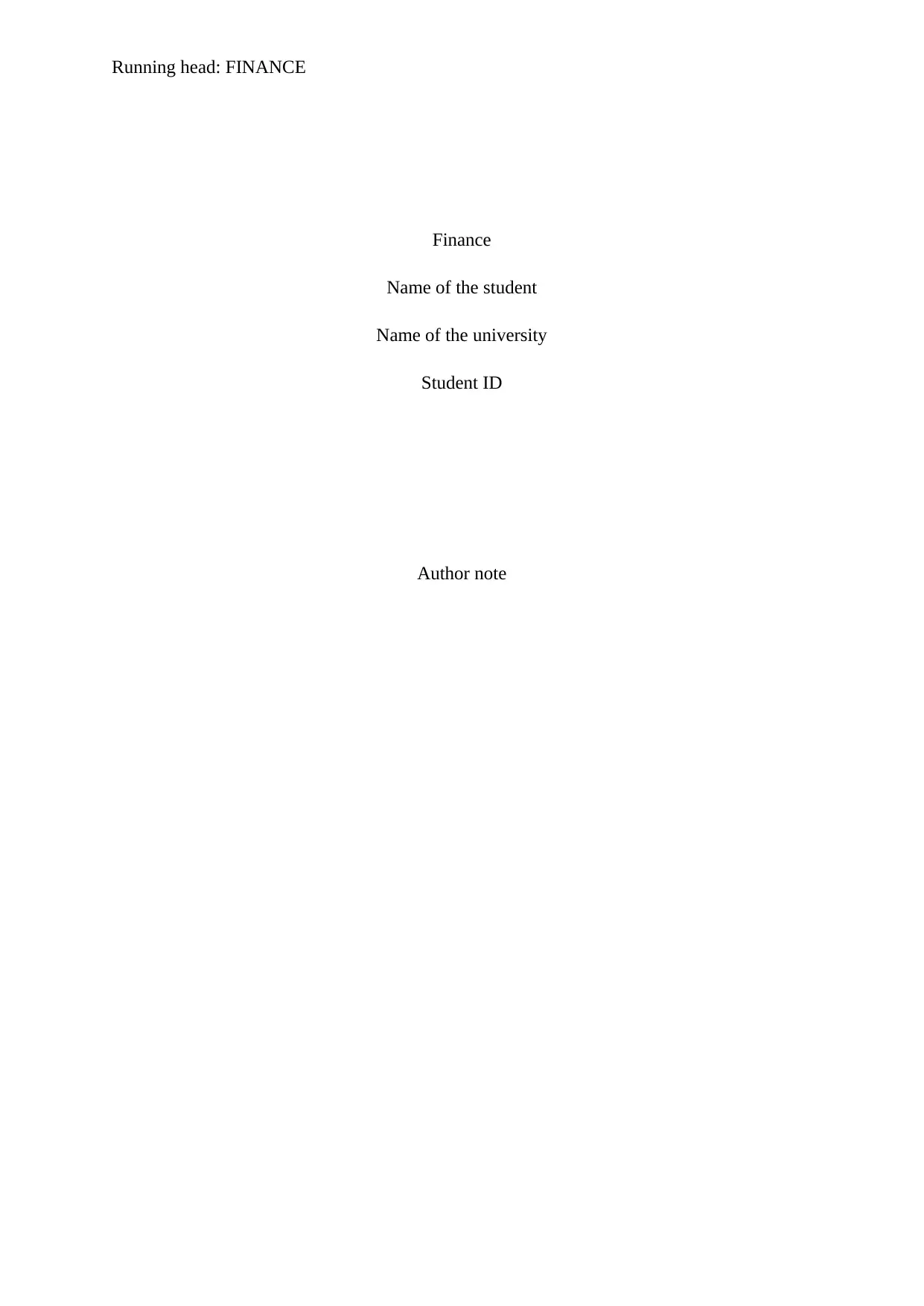
Running head: FINANCE
Finance
Name of the student
Name of the university
Student ID
Author note
Finance
Name of the student
Name of the university
Student ID
Author note
Paraphrase This Document
Need a fresh take? Get an instant paraphrase of this document with our AI Paraphraser
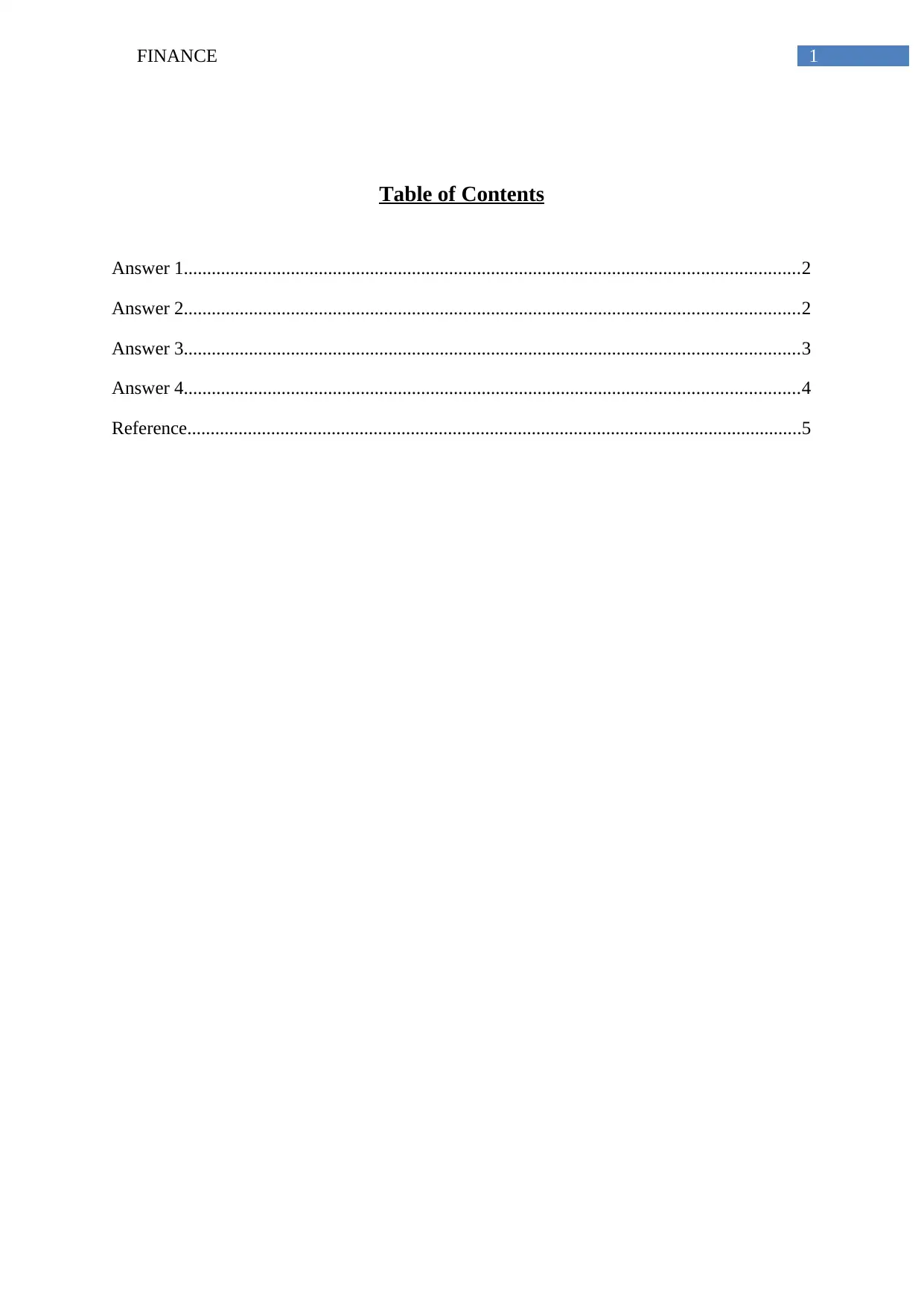
1FINANCE
Table of Contents
Answer 1....................................................................................................................................2
Answer 2....................................................................................................................................2
Answer 3....................................................................................................................................3
Answer 4....................................................................................................................................4
Reference....................................................................................................................................5
Table of Contents
Answer 1....................................................................................................................................2
Answer 2....................................................................................................................................2
Answer 3....................................................................................................................................3
Answer 4....................................................................................................................................4
Reference....................................................................................................................................5

2FINANCE
Answer 1
Moral hazard is practice of the unscrupulous lenders lenders involved in passing the
bad loans to various other market participants in addition to the unsuspecting small scale
investors at the closing for the chain.
Securitization is the tradition of parcelling the loan together into the security. The
securitization of the subprime mortgages was the focal point for the revulsion with the
business practices of bank before the crush in Canadian market.
In case of Canadian financial market, it has been found that instead of passing the bad
loans to the outside of banking system, the securitization worked for concentrating risks in
the banking sector itself. Further, banks were using the securitization process as a means to
borrow for expanding the lending and thereby increasing the leverage. Unlike the traditional
bank that depends upon the retail deposits for financing the lending the securitisation process
opened up the new sources for funding through tapping the new creditors. Hence, it can be
said that securitization is the sources of risk for the Canadian financial market (Schwarcz,
2018).
Answer 2
Securitization was one of the major causes for global financial crisis. Under the
securitization process the firm pools the assets and issues the securities with the right of
paying backed by asset pools. Banks in Canada used this process on large scale.
Securitization of the loans has its impact on various aspects as follows –
a. Credit risk – for most of the bank credit risk was the most crucial risk and loans were
the most obvious and largest sources of the credit risk. Hence, credit risk from the
loans has most important effect on the risk appetite of bank. However, the credit risk
exposure from the loans determines remaining risk appetite from various other assets.
If the bank has high exposure towards credit risk from the loans, it will not be willing
or less willing for taking the additional risk.
b. Capital adequacy ratio – before big financial crisis, the commentators worried about
the significant deficit is US account and raised the concerns regarding US dollar
depreciation. It further parallel draws the emerging market experience regarding
Answer 1
Moral hazard is practice of the unscrupulous lenders lenders involved in passing the
bad loans to various other market participants in addition to the unsuspecting small scale
investors at the closing for the chain.
Securitization is the tradition of parcelling the loan together into the security. The
securitization of the subprime mortgages was the focal point for the revulsion with the
business practices of bank before the crush in Canadian market.
In case of Canadian financial market, it has been found that instead of passing the bad
loans to the outside of banking system, the securitization worked for concentrating risks in
the banking sector itself. Further, banks were using the securitization process as a means to
borrow for expanding the lending and thereby increasing the leverage. Unlike the traditional
bank that depends upon the retail deposits for financing the lending the securitisation process
opened up the new sources for funding through tapping the new creditors. Hence, it can be
said that securitization is the sources of risk for the Canadian financial market (Schwarcz,
2018).
Answer 2
Securitization was one of the major causes for global financial crisis. Under the
securitization process the firm pools the assets and issues the securities with the right of
paying backed by asset pools. Banks in Canada used this process on large scale.
Securitization of the loans has its impact on various aspects as follows –
a. Credit risk – for most of the bank credit risk was the most crucial risk and loans were
the most obvious and largest sources of the credit risk. Hence, credit risk from the
loans has most important effect on the risk appetite of bank. However, the credit risk
exposure from the loans determines remaining risk appetite from various other assets.
If the bank has high exposure towards credit risk from the loans, it will not be willing
or less willing for taking the additional risk.
b. Capital adequacy ratio – before big financial crisis, the commentators worried about
the significant deficit is US account and raised the concerns regarding US dollar
depreciation. It further parallel draws the emerging market experience regarding
⊘ This is a preview!⊘
Do you want full access?
Subscribe today to unlock all pages.

Trusted by 1+ million students worldwide
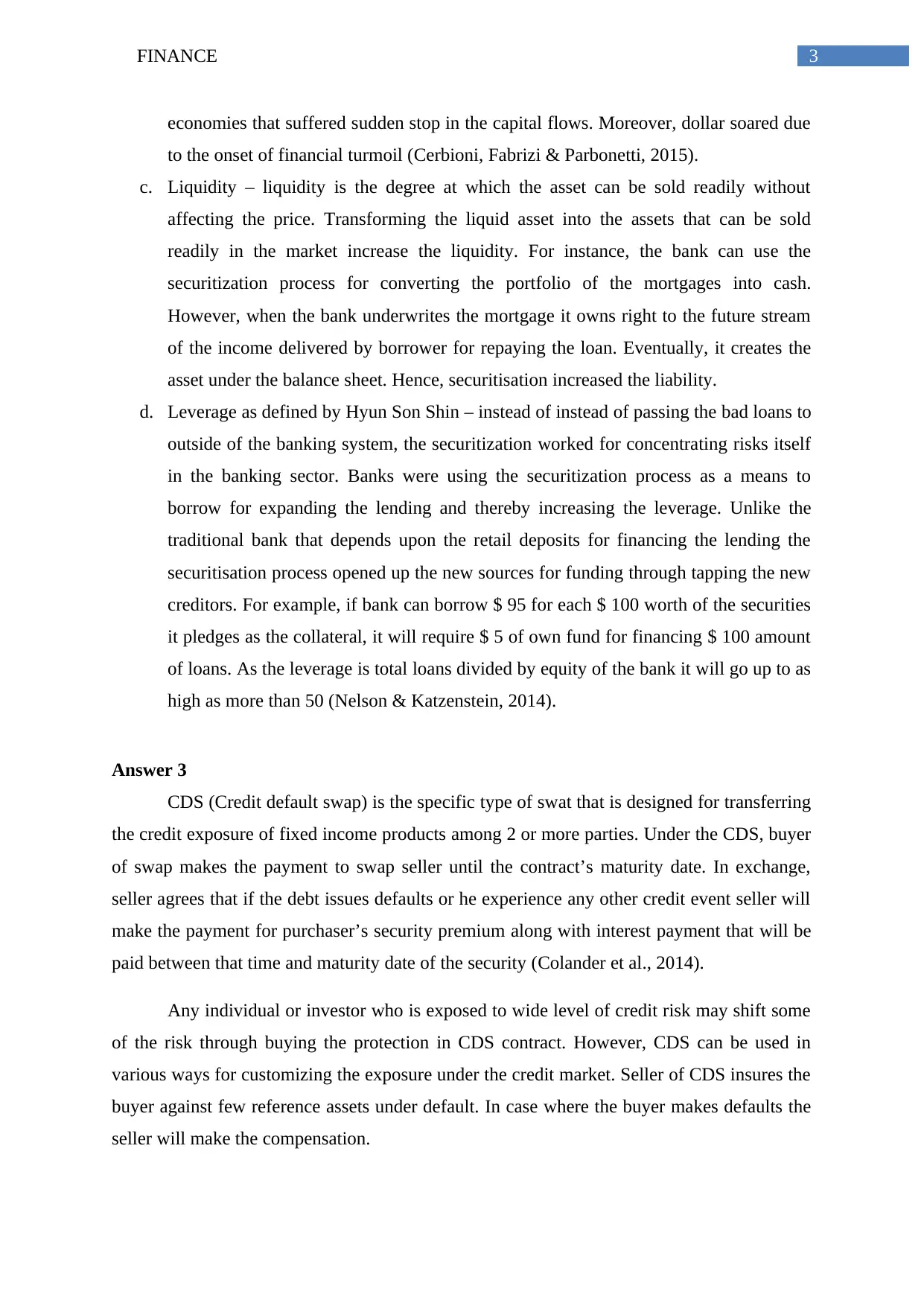
3FINANCE
economies that suffered sudden stop in the capital flows. Moreover, dollar soared due
to the onset of financial turmoil (Cerbioni, Fabrizi & Parbonetti, 2015).
c. Liquidity – liquidity is the degree at which the asset can be sold readily without
affecting the price. Transforming the liquid asset into the assets that can be sold
readily in the market increase the liquidity. For instance, the bank can use the
securitization process for converting the portfolio of the mortgages into cash.
However, when the bank underwrites the mortgage it owns right to the future stream
of the income delivered by borrower for repaying the loan. Eventually, it creates the
asset under the balance sheet. Hence, securitisation increased the liability.
d. Leverage as defined by Hyun Son Shin – instead of instead of passing the bad loans to
outside of the banking system, the securitization worked for concentrating risks itself
in the banking sector. Banks were using the securitization process as a means to
borrow for expanding the lending and thereby increasing the leverage. Unlike the
traditional bank that depends upon the retail deposits for financing the lending the
securitisation process opened up the new sources for funding through tapping the new
creditors. For example, if bank can borrow $ 95 for each $ 100 worth of the securities
it pledges as the collateral, it will require $ 5 of own fund for financing $ 100 amount
of loans. As the leverage is total loans divided by equity of the bank it will go up to as
high as more than 50 (Nelson & Katzenstein, 2014).
Answer 3
CDS (Credit default swap) is the specific type of swat that is designed for transferring
the credit exposure of fixed income products among 2 or more parties. Under the CDS, buyer
of swap makes the payment to swap seller until the contract’s maturity date. In exchange,
seller agrees that if the debt issues defaults or he experience any other credit event seller will
make the payment for purchaser’s security premium along with interest payment that will be
paid between that time and maturity date of the security (Colander et al., 2014).
Any individual or investor who is exposed to wide level of credit risk may shift some
of the risk through buying the protection in CDS contract. However, CDS can be used in
various ways for customizing the exposure under the credit market. Seller of CDS insures the
buyer against few reference assets under default. In case where the buyer makes defaults the
seller will make the compensation.
economies that suffered sudden stop in the capital flows. Moreover, dollar soared due
to the onset of financial turmoil (Cerbioni, Fabrizi & Parbonetti, 2015).
c. Liquidity – liquidity is the degree at which the asset can be sold readily without
affecting the price. Transforming the liquid asset into the assets that can be sold
readily in the market increase the liquidity. For instance, the bank can use the
securitization process for converting the portfolio of the mortgages into cash.
However, when the bank underwrites the mortgage it owns right to the future stream
of the income delivered by borrower for repaying the loan. Eventually, it creates the
asset under the balance sheet. Hence, securitisation increased the liability.
d. Leverage as defined by Hyun Son Shin – instead of instead of passing the bad loans to
outside of the banking system, the securitization worked for concentrating risks itself
in the banking sector. Banks were using the securitization process as a means to
borrow for expanding the lending and thereby increasing the leverage. Unlike the
traditional bank that depends upon the retail deposits for financing the lending the
securitisation process opened up the new sources for funding through tapping the new
creditors. For example, if bank can borrow $ 95 for each $ 100 worth of the securities
it pledges as the collateral, it will require $ 5 of own fund for financing $ 100 amount
of loans. As the leverage is total loans divided by equity of the bank it will go up to as
high as more than 50 (Nelson & Katzenstein, 2014).
Answer 3
CDS (Credit default swap) is the specific type of swat that is designed for transferring
the credit exposure of fixed income products among 2 or more parties. Under the CDS, buyer
of swap makes the payment to swap seller until the contract’s maturity date. In exchange,
seller agrees that if the debt issues defaults or he experience any other credit event seller will
make the payment for purchaser’s security premium along with interest payment that will be
paid between that time and maturity date of the security (Colander et al., 2014).
Any individual or investor who is exposed to wide level of credit risk may shift some
of the risk through buying the protection in CDS contract. However, CDS can be used in
various ways for customizing the exposure under the credit market. Seller of CDS insures the
buyer against few reference assets under default. In case where the buyer makes defaults the
seller will make the compensation.
Paraphrase This Document
Need a fresh take? Get an instant paraphrase of this document with our AI Paraphraser
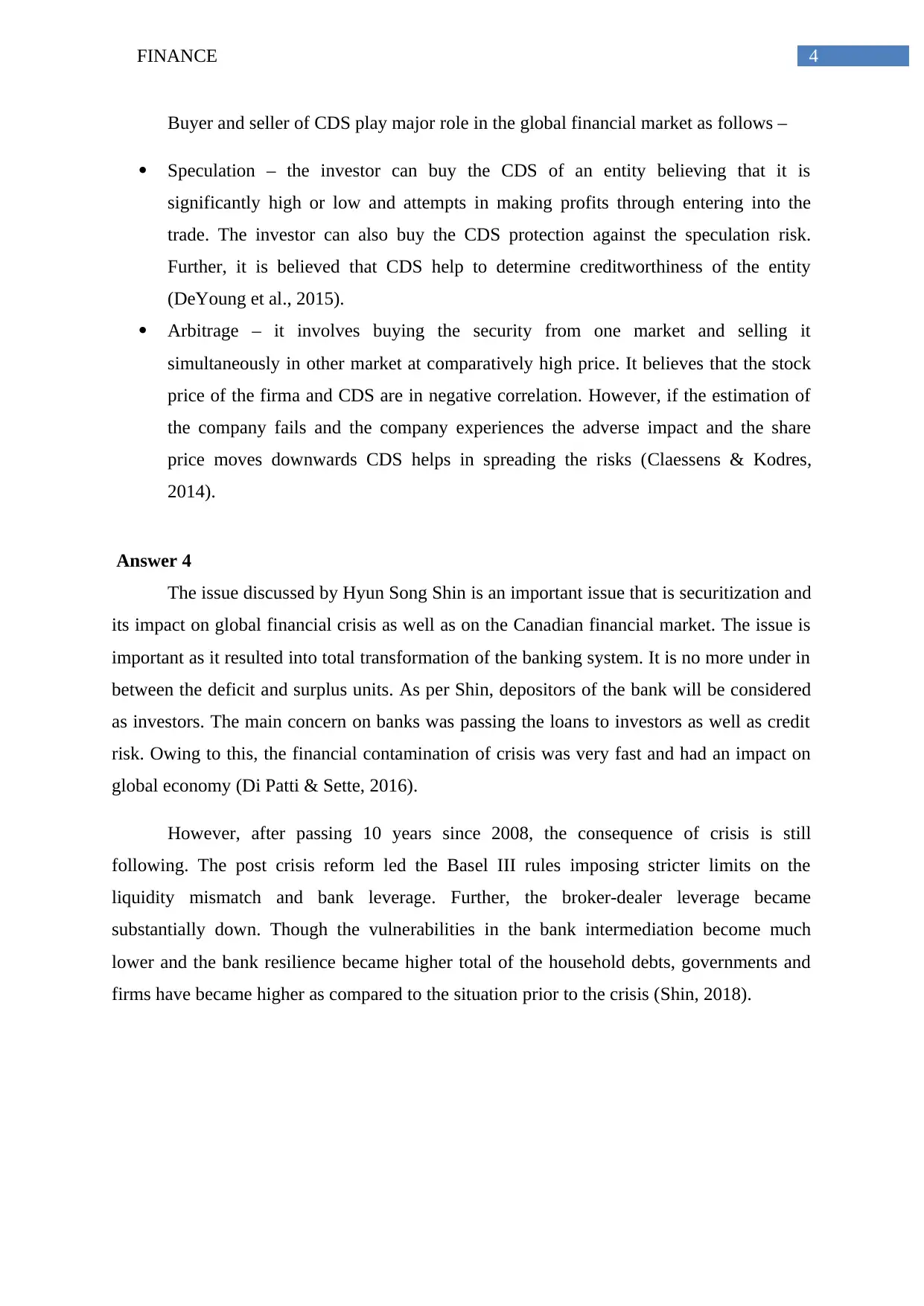
4FINANCE
Buyer and seller of CDS play major role in the global financial market as follows –
Speculation – the investor can buy the CDS of an entity believing that it is
significantly high or low and attempts in making profits through entering into the
trade. The investor can also buy the CDS protection against the speculation risk.
Further, it is believed that CDS help to determine creditworthiness of the entity
(DeYoung et al., 2015).
Arbitrage – it involves buying the security from one market and selling it
simultaneously in other market at comparatively high price. It believes that the stock
price of the firma and CDS are in negative correlation. However, if the estimation of
the company fails and the company experiences the adverse impact and the share
price moves downwards CDS helps in spreading the risks (Claessens & Kodres,
2014).
Answer 4
The issue discussed by Hyun Song Shin is an important issue that is securitization and
its impact on global financial crisis as well as on the Canadian financial market. The issue is
important as it resulted into total transformation of the banking system. It is no more under in
between the deficit and surplus units. As per Shin, depositors of the bank will be considered
as investors. The main concern on banks was passing the loans to investors as well as credit
risk. Owing to this, the financial contamination of crisis was very fast and had an impact on
global economy (Di Patti & Sette, 2016).
However, after passing 10 years since 2008, the consequence of crisis is still
following. The post crisis reform led the Basel III rules imposing stricter limits on the
liquidity mismatch and bank leverage. Further, the broker-dealer leverage became
substantially down. Though the vulnerabilities in the bank intermediation become much
lower and the bank resilience became higher total of the household debts, governments and
firms have became higher as compared to the situation prior to the crisis (Shin, 2018).
Buyer and seller of CDS play major role in the global financial market as follows –
Speculation – the investor can buy the CDS of an entity believing that it is
significantly high or low and attempts in making profits through entering into the
trade. The investor can also buy the CDS protection against the speculation risk.
Further, it is believed that CDS help to determine creditworthiness of the entity
(DeYoung et al., 2015).
Arbitrage – it involves buying the security from one market and selling it
simultaneously in other market at comparatively high price. It believes that the stock
price of the firma and CDS are in negative correlation. However, if the estimation of
the company fails and the company experiences the adverse impact and the share
price moves downwards CDS helps in spreading the risks (Claessens & Kodres,
2014).
Answer 4
The issue discussed by Hyun Song Shin is an important issue that is securitization and
its impact on global financial crisis as well as on the Canadian financial market. The issue is
important as it resulted into total transformation of the banking system. It is no more under in
between the deficit and surplus units. As per Shin, depositors of the bank will be considered
as investors. The main concern on banks was passing the loans to investors as well as credit
risk. Owing to this, the financial contamination of crisis was very fast and had an impact on
global economy (Di Patti & Sette, 2016).
However, after passing 10 years since 2008, the consequence of crisis is still
following. The post crisis reform led the Basel III rules imposing stricter limits on the
liquidity mismatch and bank leverage. Further, the broker-dealer leverage became
substantially down. Though the vulnerabilities in the bank intermediation become much
lower and the bank resilience became higher total of the household debts, governments and
firms have became higher as compared to the situation prior to the crisis (Shin, 2018).
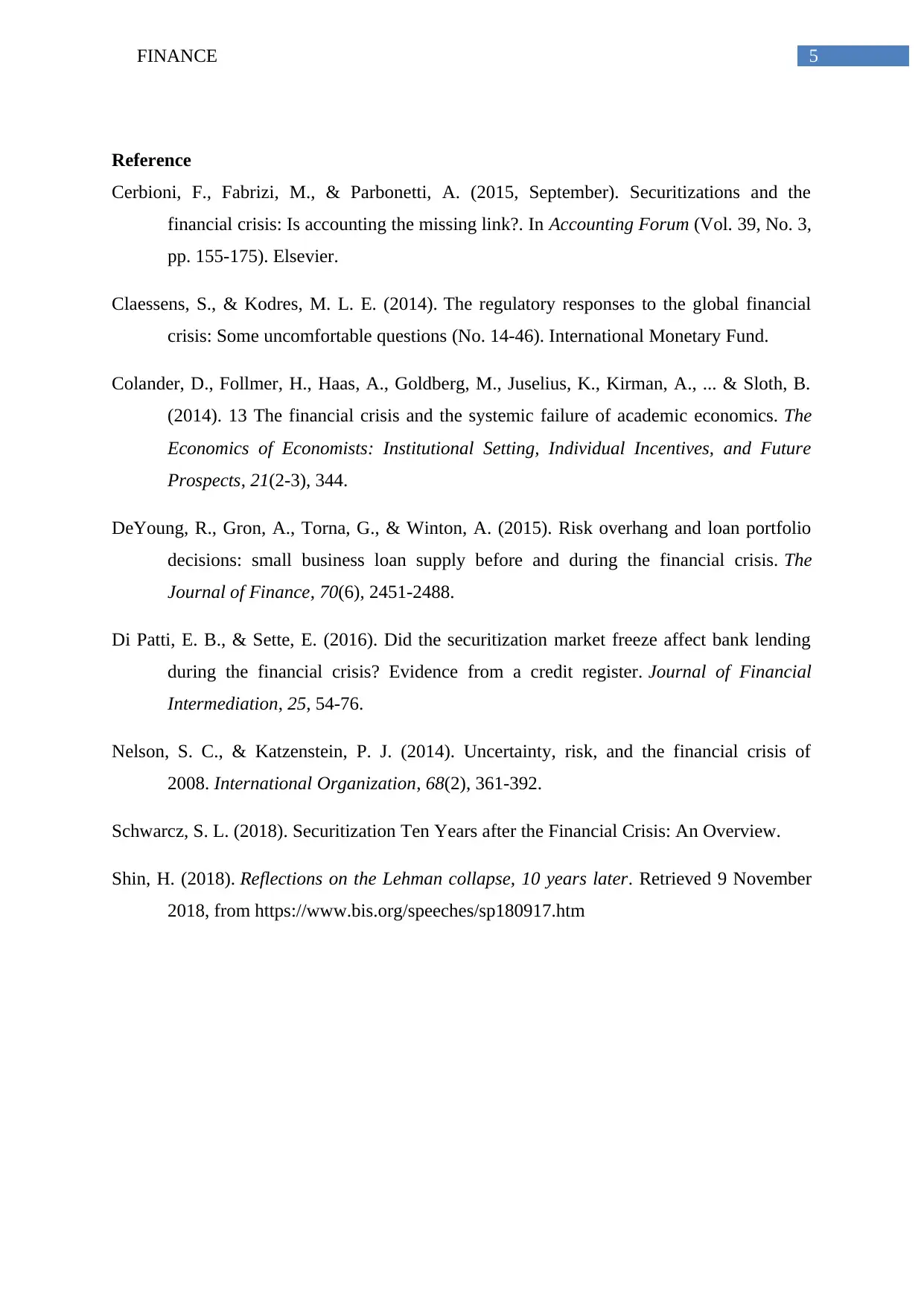
5FINANCE
Reference
Cerbioni, F., Fabrizi, M., & Parbonetti, A. (2015, September). Securitizations and the
financial crisis: Is accounting the missing link?. In Accounting Forum (Vol. 39, No. 3,
pp. 155-175). Elsevier.
Claessens, S., & Kodres, M. L. E. (2014). The regulatory responses to the global financial
crisis: Some uncomfortable questions (No. 14-46). International Monetary Fund.
Colander, D., Follmer, H., Haas, A., Goldberg, M., Juselius, K., Kirman, A., ... & Sloth, B.
(2014). 13 The financial crisis and the systemic failure of academic economics. The
Economics of Economists: Institutional Setting, Individual Incentives, and Future
Prospects, 21(2-3), 344.
DeYoung, R., Gron, A., Torna, G., & Winton, A. (2015). Risk overhang and loan portfolio
decisions: small business loan supply before and during the financial crisis. The
Journal of Finance, 70(6), 2451-2488.
Di Patti, E. B., & Sette, E. (2016). Did the securitization market freeze affect bank lending
during the financial crisis? Evidence from a credit register. Journal of Financial
Intermediation, 25, 54-76.
Nelson, S. C., & Katzenstein, P. J. (2014). Uncertainty, risk, and the financial crisis of
2008. International Organization, 68(2), 361-392.
Schwarcz, S. L. (2018). Securitization Ten Years after the Financial Crisis: An Overview.
Shin, H. (2018). Reflections on the Lehman collapse, 10 years later. Retrieved 9 November
2018, from https://www.bis.org/speeches/sp180917.htm
Reference
Cerbioni, F., Fabrizi, M., & Parbonetti, A. (2015, September). Securitizations and the
financial crisis: Is accounting the missing link?. In Accounting Forum (Vol. 39, No. 3,
pp. 155-175). Elsevier.
Claessens, S., & Kodres, M. L. E. (2014). The regulatory responses to the global financial
crisis: Some uncomfortable questions (No. 14-46). International Monetary Fund.
Colander, D., Follmer, H., Haas, A., Goldberg, M., Juselius, K., Kirman, A., ... & Sloth, B.
(2014). 13 The financial crisis and the systemic failure of academic economics. The
Economics of Economists: Institutional Setting, Individual Incentives, and Future
Prospects, 21(2-3), 344.
DeYoung, R., Gron, A., Torna, G., & Winton, A. (2015). Risk overhang and loan portfolio
decisions: small business loan supply before and during the financial crisis. The
Journal of Finance, 70(6), 2451-2488.
Di Patti, E. B., & Sette, E. (2016). Did the securitization market freeze affect bank lending
during the financial crisis? Evidence from a credit register. Journal of Financial
Intermediation, 25, 54-76.
Nelson, S. C., & Katzenstein, P. J. (2014). Uncertainty, risk, and the financial crisis of
2008. International Organization, 68(2), 361-392.
Schwarcz, S. L. (2018). Securitization Ten Years after the Financial Crisis: An Overview.
Shin, H. (2018). Reflections on the Lehman collapse, 10 years later. Retrieved 9 November
2018, from https://www.bis.org/speeches/sp180917.htm
⊘ This is a preview!⊘
Do you want full access?
Subscribe today to unlock all pages.

Trusted by 1+ million students worldwide
1 out of 6
Related Documents
Your All-in-One AI-Powered Toolkit for Academic Success.
+13062052269
info@desklib.com
Available 24*7 on WhatsApp / Email
![[object Object]](/_next/static/media/star-bottom.7253800d.svg)
Unlock your academic potential
Copyright © 2020–2026 A2Z Services. All Rights Reserved. Developed and managed by ZUCOL.





